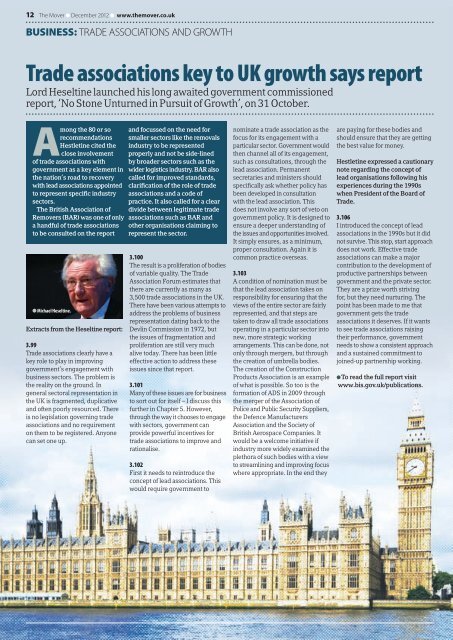The Mover December 2012
The Mover December 2012
The Mover December 2012
You also want an ePaper? Increase the reach of your titles
YUMPU automatically turns print PDFs into web optimized ePapers that Google loves.
12 <strong>The</strong> <strong>Mover</strong> ● <strong>December</strong> <strong>2012</strong> ● www.themover.co.ukBUSINESS: TRADE ASSOCIATIONS AND GROWTHTrade associations key to UK growth says reportLord Heseltine launched his long awaited government commissionedreport, ‘No Stone Unturned in Pursuit of Growth’, on 31 October.Among the 80 or so and focussed on the need forrecommendations smaller sectors like the removalsHestletine cited the industry to be representedclose involvement properly and not be side-linedof trade associations with by broader sectors such as thegovernment as a key element in wider logistics industry. BAR alsothe nation’s road to recovery called for improved standards,with lead associations appointed clarification of the role of tradeto represent specific industry associations and a code ofsectors.practice. It also called for a clear<strong>The</strong> British Association of divide between legitimate tradeRemovers (BAR) was one of only associations such as BAR anda handful of trade associations other organisations claiming toto be consulted on the report represent the sector.● Michael Heseltine.Extracts from the Heseltine report:3.99Trade associations clearly have akey role to play in improvinggovernment’s engagement withbusiness sectors. <strong>The</strong> problem isthe reality on the ground. Ingeneral sectoral representation inthe UK is fragmented, duplicativeand often poorly resourced. <strong>The</strong>reis no legislation governing tradeassociations and no requirementon them to be registered. Anyonecan set one up.3.100<strong>The</strong> result is a proliferation of bodiesof variable quality. <strong>The</strong> TradeAssociation Forum estimates thatthere are currently as many as3,500 trade associations in the UK.<strong>The</strong>re have been various attempts toaddress the problems of businessrepresentation dating back to theDevlin Commission in 1972, butthe issues of fragmentation andproliferation are still very muchalive today. <strong>The</strong>re has been littleeffective action to address theseissues since that report.3.101Many of these issues are for businessto sort out for itself – I discuss thisfurther in Chapter 5. However,through the way it chooses to engagewith sectors, government canprovide powerful incentives fortrade associations to improve andrationalise.3.102First it needs to reintroduce theconcept of lead associations. Thiswould require government tonominate a trade association as thefocus for its engagement with aparticular sector. Government wouldthen channel all of its engagement,such as consultations, through thelead association. Permanentsecretaries and ministers shouldspecifically ask whether policy hasbeen developed in consultationwith the lead association. Thisdoes not involve any sort of veto ongovernment policy. It is designed toensure a deeper understanding ofthe issues and opportunities involved.It simply ensures, as a minimum,proper consultation. Again it iscommon practice overseas.3.103A condition of nomination must bethat the lead association takes onresponsibility for ensuring that theviews of the entire sector are fairlyrepresented, and that steps aretaken to draw all trade associationsoperating in a particular sector intonew, more strategic workingarrangements. This can be done, notonly through mergers, but throughthe creation of umbrella bodies.<strong>The</strong> creation of the ConstructionProducts Association is an exampleof what is possible. So too is theformation of ADS in 2009 throughthe merger of the Association ofPolice and Public Security Suppliers,the Defence ManufacturersAssociation and the Society ofBritish Aerospace Companies. Itwould be a welcome initiative ifindustry more widely examined theplethora of such bodies with a viewto streamlining and improving focuswhere appropriate. In the end theyare paying for these bodies andshould ensure that they are gettingthe best value for money.Hestletine expressed a cautionarynote regarding the concept oflead organisations following hisexperiences during the 1990swhen President of the Board ofTrade.3.106I introduced the concept of leadassociations in the 1990s but it didnot survive. This stop, start approachdoes not work. Effective tradeassociations can make a majorcontribution to the development ofproductive partnerships betweengovernment and the private sector.<strong>The</strong>y are a prize worth strivingfor, but they need nurturing. <strong>The</strong>point has been made to me thatgovernment gets the tradeassociations it deserves. If it wantsto see trade associations raisingtheir performance, governmentneeds to show a consistent approachand a sustained commitment tojoined-up partnership working.● To read the full report visitwww.bis.gov.uk/publications.



